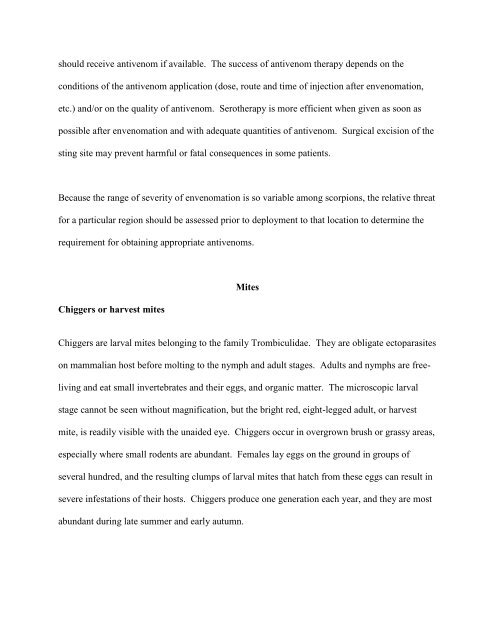Field Guide to Venomous and Medically Important Invertebrates ...
Field Guide to Venomous and Medically Important Invertebrates ...
Field Guide to Venomous and Medically Important Invertebrates ...
Create successful ePaper yourself
Turn your PDF publications into a flip-book with our unique Google optimized e-Paper software.
should receive antivenom if available. The success of antivenom therapy depends on the<br />
conditions of the antivenom application (dose, route <strong>and</strong> time of injection after envenomation,<br />
etc.) <strong>and</strong>/or on the quality of antivenom. Serotherapy is more efficient when given as soon as<br />
possible after envenomation <strong>and</strong> with adequate quantities of antivenom. Surgical excision of the<br />
sting site may prevent harmful or fatal consequences in some patients.<br />
Because the range of severity of envenomation is so variable among scorpions, the relative threat<br />
for a particular region should be assessed prior <strong>to</strong> deployment <strong>to</strong> that location <strong>to</strong> determine the<br />
requirement for obtaining appropriate antivenoms.<br />
Chiggers or harvest mites<br />
Mites<br />
Chiggers are larval mites belonging <strong>to</strong> the family Trombiculidae. They are obligate ec<strong>to</strong>parasites<br />
on mammalian host before molting <strong>to</strong> the nymph <strong>and</strong> adult stages. Adults <strong>and</strong> nymphs are free-<br />
living <strong>and</strong> eat small invertebrates <strong>and</strong> their eggs, <strong>and</strong> organic matter. The microscopic larval<br />
stage cannot be seen without magnification, but the bright red, eight-legged adult, or harvest<br />
mite, is readily visible with the unaided eye. Chiggers occur in overgrown brush or grassy areas,<br />
especially where small rodents are abundant. Females lay eggs on the ground in groups of<br />
several hundred, <strong>and</strong> the resulting clumps of larval mites that hatch from these eggs can result in<br />
severe infestations of their hosts. Chiggers produce one generation each year, <strong>and</strong> they are most<br />
abundant during late summer <strong>and</strong> early autumn.

















